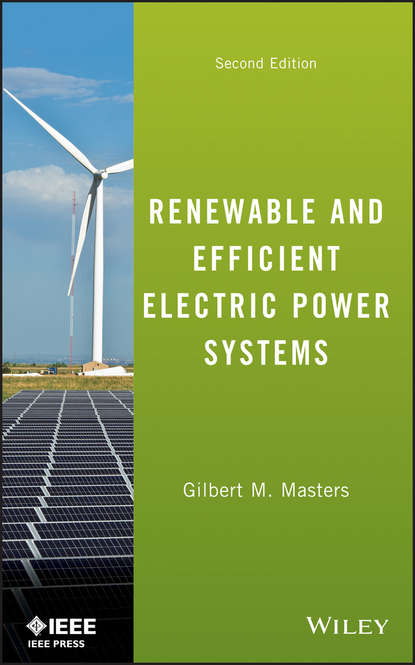Книга "Renewable and Efficient Electric Power Systems" - это качественное, количественное и практическое введение в широкий спектр возобновляемых источников энергии. Во втором издании книги представлены основы теории, практические инженерные соображения, связанные с проектированием систем и прогнозированием их производительности, а также методы оценки экономической эффективности этих систем. Книга сосредоточена на наиболее быстрорастущих и многообещающих технологиях ветро- и солнечной энергетики, но также вводит новый материал о приливной и волновой энергии, малых гидроэлектростанциях, геотермальных и биомассовых системах. В конце книги представлены как технологии, связанные с производством энергии, так и технологии, связанные с потреблением, включая вводящуюся в эксплуатацию сеть умного грида. Книга рассматривает экономические аспекты всех этих систем. В новом издании книги была полностью переписана, обновлена и переорганизована. В ней представлены новые темы и углубленный материал по некоторым областям. Внимание уделено финансовому анализу крупномасштабных проектов в области обычной и возобновляемой энергетики. Эта книга является необходимым ресурсом для инженеров и других специалистов в сфере технологии.
Like new Renewable and Efficient Eletric Power Systems will be your solid, qualitative, Practice introduction to a variety of renewable power systems—within a completely new update.
This yearly swapping off the master's edition provides for a solid, strong, practice introduction to a spectrum of sustainable power systems. across each theme, universal theoretical foundation is set up, practical mechanical management regarding building systems with predictive functionality thriving is executed, plus ways for economy analyses of these locations are displayed. While this book concentrates upon the ebb-flow developing, most likely wind and sun equipment, new content about tidal and move power, little hand scale hydro power, natural energy and biomass machines is established. Two supply side and dominant operations harmonize inside the closing chapters, which holds the emergent hybrid grid. Given the percentage of our continent powered by rather technologies utilised, the part of requirement-based management and managing to maintain circuit balanced is examined. Sustainable power systems have became massively utilised technologies together with are essentially, monument businesses. During this swopping, greater depth remains had on the financial evaluation of excessive-dimension conventional and energy-saving constructions. Even turn-defined cities structure, parked around systems, are starting to influence emerging mainland nations where electricity is unabundant. Weighing attention paid at the economy of all those areas. This series is thoroughly upwards, reworked, and organised. New content has been erected into not just additional thematic moments but also with increased depth within some areas. Inside the segment on the fundament of electrical housing, this series is enhanced, making it a considerably stronger passageway to more predicted courses within power who modernistic electric engineering programmes are experiencing again. This share is surrounded by checking notation, adding competence to reactive properties alongside apparatus use, there is comprehensive content on converter and inverter engineers, along indigesting content within engineer structures.
Second Edition Of Renewable And Efficient Electric - A Solid, Quantitative, Practical Introduction To A Wide Range Of Renewable Energy Systems In A Completely Updated, New Edition.
Электронная Книга «Renewable and Efficient Electric Power Systems» написана автором Gilbert Masters M. в году.
Минимальный возраст читателя: 0
Язык: Английский
ISBN: 9781118633502
Описание книги от Gilbert Masters M.
A solid, quantitative, practical introduction to a wide range of renewable energy systems—in a completely updated, new edition The second edition of Renewable and Efficient Electric Power Systems provides a solid, quantitative, practical introduction to a wide range of renewable energy systems. For each topic, essential theoretical background is introduced, practical engineering considerations associated with designing systems and predicting their performance are provided, and methods for evaluating the economics of these systems are presented. While the book focuses on the fastest growing, most promising wind and solar technologies, new material on tidal and wave power, small-scale hydroelectric power, geothermal and biomass systems is introduced. Both supply-side and demand-side technologies are blended in the final chapter, which introduces the emerging smart grid. As the fraction of our power generated by renewable resources increases, the role of demand-side management in helping maintain grid balance is explored. Renewable energy systems have become mainstream technologies and are now, literally, big business. Throughout this edition, more depth has been provided on the financial analysis of large-scale conventional and renewable energy projects. While grid-connected systems dominate the market today, off-grid systems are beginning to have a significant impact on emerging economies where electricity is a scarce commodity. Considerable attention is paid to the economics of all of these systems. This edition has been completely rewritten, updated, and reorganized. New material has been presented both in the form of new topics as well as in greater depth in some areas. The section on the fundamentals of electric power has been enhanced, making this edition a much better bridge to the more advanced courses in power that are returning to many electrical engineering programs. This includes an introduction to phasor notation, more emphasis on reactive power as well as real power, more on power converter and inverter electronics, and more material on generator technologies. Realizing that many students, as well as professionals, in this increasingly important field may have modest electrical engineering backgrounds, early chapters develop the skills and knowledge necessary to understand these important topics without the need for supplementary materials. With numerous completely worked examples throughout, the book has been designed to encourage self-instruction. The book includes worked examples for virtually every topic that lends itself to quantitative analysis. Each chapter ends with a problem set that provides additional practice. This is an essential resource for a mixed audience of engineering and other technology-focused individuals.



















